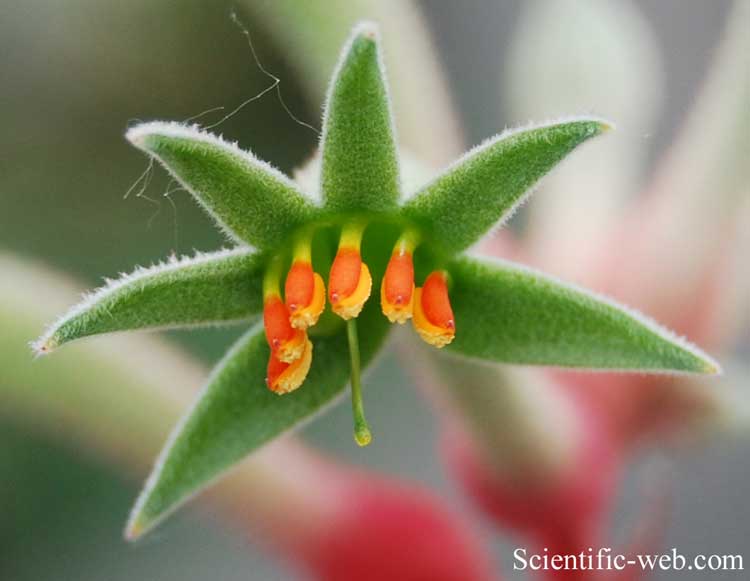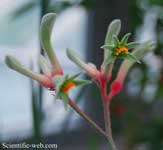
Anigozanthos flavidus, Photo: Michael Lahanas
Classification System: APG IV
Superregnum: Eukaryota
Regnum: Plantae
Cladus: Angiosperms
Cladus: Monocots
Cladus: Commelinids
Ordo: Commelinaless
Familia: Haemodoraceae
Subfamilia: Conostyloideae
Genus: Anigozanthos
Species: Anigozanthos flavidus
Name
Anigozanthos flavidus Redouté, 1807
Synonyms
Anigosia flavida (DC.) Salisb., Trans. Hort. Soc. 1: (1812) 327
Anigozanthos coccinea Paxton, Bot. Mag. 5: 271 (1838)
Anigozanthos flavescens Steud., Nom. ed. II. 1: 98 (1840)
Anigozanthos flavidus var. bicolor Lindl., Bot. Reg. 24: t. 64 (1838)
Anigozanthos grandiflora Salisb., Parad. Lond. t. 97 (1808)
Anigozanthos manglesii Maund, Botanist, t. 67 (1838)
Schwaegrichenia flavida (DC.) Spreng., Pugill. 2: 58 (1815)
Distribution
Native distribution areas:
Continental: Australasia
Regional: Australia
(Western Australia: Augusta E to Two Peoples Bay and N to Waroona)
References: Brummitt, R.K. 2001. TDWG – World Geographical Scheme for Recording Plant Distributions, 2nd Edition
References
Primary references
Redouté, P-J. 1805–1807. Les Liliacées. Vol. 3. pl. 121–180. Paris: chez l'auteur. BHL Reference page. : 3: t. 176.
Additional references
Govaerts, R.H.A. 1995. World Checklist of Seed Plants 1(1, 2). 483, 529 pp. MIM, Deurne. ISBN 90-341-0852-X (issue 1) ISBN 90-341-0853-8 (issue 2). Reference page.
Links
Govaerts, R. et al. 2021. Anigozanthos flavidus in Kew Science Plants of the World online. The Board of Trustees of the Royal Botanic Gardens, Kew. Published online. Accessed: 2021 Oct 01. Reference page.
International Plant Names Index. Oct. Anigozanthos flavidus. Published online. Accessed: 01 Oct.
Tropicos.org Oct. Anigozanthos flavidus. Missouri Botanical Garden. Published online. Accessed: {{{4}}} 01 Oct.
Hassler, M. 2021. Anigozanthos flavidus. World Plants: Synonymic Checklists of the Vascular Plants of the World In: Roskovh, Y., Abucay, L., Orrell, T., Nicolson, D., Bailly, N., Kirk, P., Bourgoin, T., DeWalt, R.E., Decock, W., De Wever, A., Nieukerken, E. van, Zarucchi, J. & Penev, L., eds. 2021. Species 2000 & ITIS Catalogue of Life. Published online. Accessed: 2021 Oct 01. Reference page.
USDA, ARS, Germplasm Resources Information Network. Anigozanthos flavidus in the Germplasm Resources Information Network (GRIN), U.S. Department of Agriculture Agricultural Research Service. Accessed: 07-Oct-06.
Vernacular names
čeština: Klokanka žlutavá
svenska: Gul kängurutass
中文: 袋鼠爪花
Anigozanthos flavidus is a species of plant found in Southwest Australia. It is member of the Haemodoraceae family. It is commonly known as the tall, yellow, or evergreen, kangaroo paw. The specific epithet, flavidus, refers to the yellow flowers of this plant.[2]
A member of the genus Anigozanthos (kangaroo- and cats-paws) that has an evergreen clump of strap-like leaves, up to 1 metre long and 0.2 m wide, growing from an underground rhizome around 0.5 m in diameter. The rhizome allows the species to regenerate after drought or fire. Each plant may produce over 350 flowers, on up to 10 long stems, these appear during the summer of the region. Pollen is distributed by birds as they plunge into the flowers to reach the nectaries. Flowers are frequently yellow and green, but may present in shades of red, pink, orange, or brown.[3] It is found along roadsides, along creeks, and in forests and swamps, and other unshaded winterwet habitat.[2]
The species occurs in a range from Two Peoples Bay in the southeast, throughout the Warren and southern Jarrah Forest, to Waroona on the Swan Coastal Plain.[3] It was previously endemic to the region, but is now naturalised in New South Wales. This kangaroo paw is now widely cultivated in the Eastern states of Australia and the United States of America. Anigozanthos flavidus hybridises with other members of the genus, and is used in the development of cultivars. It is a hardy plant, tolerant of a wide range of soil types and condition, that may live for around 30 years in a garden. It is propagated from seed or sections of the rhizome.[2]
The first description of the species was by Augustin Pyramus de Candolle in 1807.[4] This was published in Redouté's Les Liliacees with an illustration by that artist.
References
Candolle, A.P. de in Redoute, P.J. (1807), Les Liliacees ... a Paris: t. 176 Type: "Cette plante est indigène de la Nouvelle-Hollande; ses graines, qui faisaient partie de celles rapportées du capitaine Baudin, ont levé dans les jardins de Paris ..."
Baum, Melita (13 April 2006). "Anigozanthos flavidus". Growing Native Plants. Australian National Herbarium.
"Anigozanthos flavidus DC". FloraBase. Western Australian Government Department of Biodiversity, Conservation and Attractions.
"Anigozanthos flavidus DC. ( as `Anigosanthos flavida' )". Australian Plant Name Index (APNI), IBIS database. Centre for Plant Biodiversity Research, Australian Government.
Retrieved from "http://en.wikipedia.org/"
All text is available under the terms of the GNU Free Documentation License


